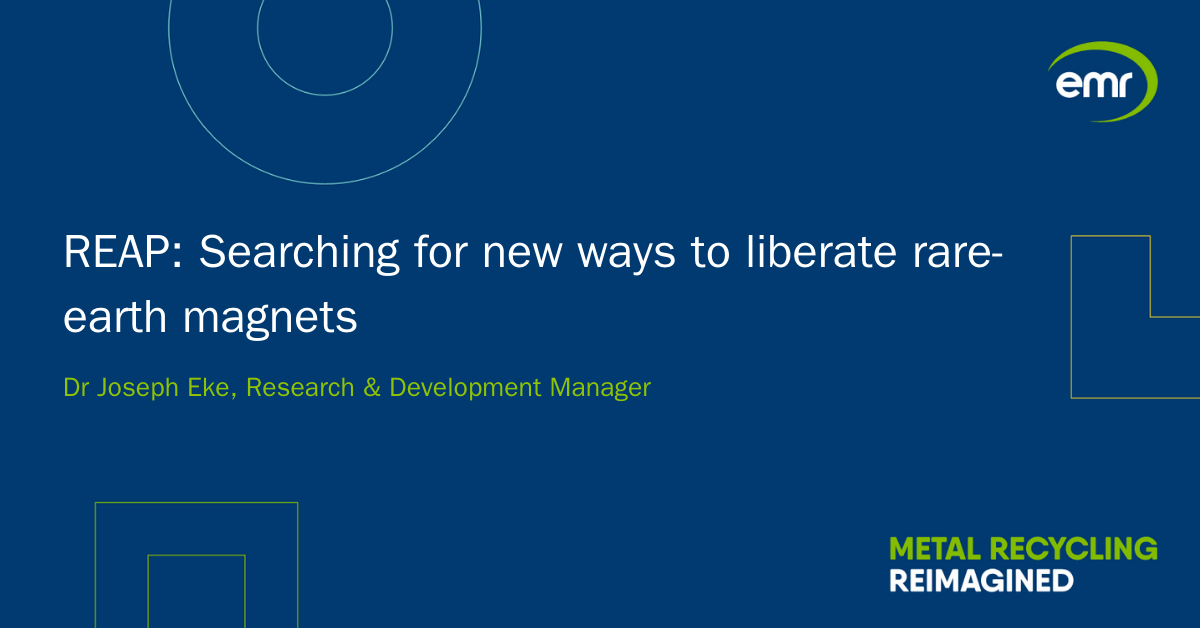CHOOSE
A DIFFERENT TERRITORY

As technology and lifestyles have changed, the materials that we recyclers must process has also started to change. A good example is the sophisticated rare-earth magnet materials that are found increasingly in flat screen TVs and end-of-life (ELV) electric vehicles.
Among these rare-earth materials are neodymium (NdFeB) magnets. These strong, effective magnets have many uses but they also come with a catch: neodymium is an element that must be mined and shipped across the globe from countries such as China and India.
In years gone by, NdFeB magnets have simply gone into the shedder for processing with the rest of an ELV or electronic appliance. It means that these finite resources have been essentially lost to the waste stream. They usually smash in the shredder and pieces stick to other pieces of steel, making them unrecoverable.
In a world where consumers demand sustainable products and manufacturers are looking to avoid the use of nature-depleting virgin metals, it is thankfully no longer acceptable to simply throw away these rare-earth metals.
At EMR, our research team recently worked with the University of Birmingham and HyProMag on a project to develop new ways to extract rare earth magnets, liberating them from the devices they’re in and then creating a supply chain to process them for use in the next generation of electronics.
This partnership, Rare-earth Extraction from Audio Products (REAP), utilised new technology to extract and process NdFeB magnets. The University of Birmingham and HyProMag then used a patented method of hydrogen decrepitation to achieve the hydrogen processing of magnet scrap.
During REAP, EMR and its partners proved that this system worked and could deliver recycled magnet materials back into the supply chain. The challenge, however, is to find a way of doing this that’s both cost effective and efficient.
At EMR, our teams worked hard to find out where these magnets exist in end-of-life vehicles and electronics and then attempted to extract them within a time that would ultimately make the hydrogen process profitable, if scaled up.
Initially, we looked at ELVs manufactured between 2009 and 2014. These vehicles had, on average, 280 magnetic components. On further study, however, just 3 percent of these magnets contained neodymium. The rest were iron-based ferromagnets, which are already recycled by EMR through the shredding process.
The team then looked at flat screen TV speakers and, of those analysed, 75 percent contained neodymium. Multiple processing trials were conducted, which demonstrated that, with further automation, it should be possible to extract them within the 15 second target set by the team.
This isn’t the end of the story, however. There are three separate factors which point to a future where rare-earth magnets play a part in the circular economy.
Firstly, these magnets are only going to become more abundant in the future. The drive motors of electric vehicles alone can contain up to 2kg of NdFeB magnets, much more than the cars coming to their end of life today.
Wider market conditions are also going to play a role. Since plans for the REAP partnership were first conceived, the price of virgin neodymium has doubled and the lead time for deliveries has more than trebled. In a world of higher prices, recycled rare-earth magnets could quickly become the less expensive solution.
Finally, EMR and its partners are also continuing the search for new and better ways to liberate these precious materials and get them back to manufacturers as simply and quickly as possible. Artificial intelligence, robotics and a better understanding of how these electronic devices are made could all offer a way to scale up the extraction of rare-earth magnets that isn’t possible today.
And you can be sure that, with its track record of investing in research and building partnerships, EMR will be ready to grasp the opportunity as soon as it is within reach.